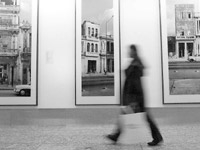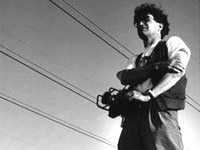 The cultural pages of most Beijing newspapers this week
have been carrying headlines to this effect: "Photo exhibition of master
filmmaker tours China."
The cultural pages of most Beijing newspapers this week
have been carrying headlines to this effect: "Photo exhibition of master
filmmaker tours China."
The headlines need a little explaining. German artist Wim Wenders is best
known among the city's art lovers not for his photos, but as director of the two
films "Paris, Texas" (1984) and "Wings of Desire" (1987).
The latter, a German film much loved in China, has a beautiful Chinese title
"Bolin Cangqiong Xia," which translates roughly as "blue sky over Berlin."
It was remade by Brad Silberling into "City of Angels" in 1998, starring
Nicolas Cage and Meg Ryan. The German film begins in black and white, with the
story being told from the point of view of two gentle, trench-coated angels, who
listen to the tortured souls of mortals and try to comfort them beneath the gray
sky of war-scarred Berlin.
It blossoms into colour only when the angels see the world of humankind after
they abandon heaven for human love and experience the simple joys of human
experience like drinking a cup of coffee or having a cigarette.
|

Wim
Wenders
|
In the exhibit, you can
still feel you are seeing the world through the sympathetic but disturbingly
sober eyes of the angels through the artist's 34 giant-sized photos on show,
which are bursting with colour.
The exhibition, titled "Pictures from the Surface of the Earth," is on until
March 21 at the Millennium Art Museum of the China Millennium Monument.
Visitors to the show (tickets are 20 yuan (US$2.40) per person), can enjoy
Wenders' films for free at an auditorium beside the exhibition hall.
The show is to hit the Shanghai Museum of Art in April and the Guangdong
Museum of Art in May, supported by the German embassy and consulates in China,
the Goethe Institute in Beijing, the Beijing Film Academy, Peking University,
Dushu magazine and is sponsored by BMW and Motorola China.
It comes to China after showings in the Museum Hamburger Bahnhof in Berlin,
the Guggenheim Museum in Bilbao, Spain and the Museum of Contemporary Art in
Sydney, Australia, said Chen Yang, co-curator of the exhibition with the
Millennium Art Museum.
Some of the photographs go back as far as 1983, when Wenders, a prominent
figure on the international film scene, began to use photography as an art
medium while scouting for locations for "Paris, Texas."
The still images include scenes in towns across the United States, landscapes
in Cuba, forests and temples in Japan, cemeteries in Jerusalem, the coast of
Galilee and the deserted expanses of the Australian outback.
"Photography lets you capture the essence of a place the first time you see
it," said the filmmaker, who is to arrive in Beijing next month.
"Before you see the picture, you feel it coming to you, you hear its call.
Landscapes sometimes are dying to tell their stories, to pass them on."
Wandering around the exhibition hall, where the photos, some 4-metre- tall,
hang from the roof, one feels like a soul floating in the air gazing at cities
of the earth.
Unlike the moving pictures, in the exhibit each of the photographs stands on
its own, creating its own individual context, independent of the other shots in
the series.
Through the detached eye of the camera, you look at a Hitchcock-style parking
lot in Houston, Texas, where a woman and two cars wait in the middle of the
picture, besieged by the darkness approaching from above and below.
Yet most of Wenders' shots of the wild landscapes of the West United States
are devoid of human existence, featuring empty shops, deserted gas stations and
signs pointing to places that have long since disappeared, said Cui Qiao, who is
also a co-curator of the show.
Wenders shows visitors through the gate of an empty house in Las Vegas,
nevada, and writes:
"Houses have faces
and characters,
like people.
This one, with the wrinkles on its forehead,
Made me laugh and feel sad
At the same time."
He captures touching details of the Old Jewish Quarter in Berlin, of the
"Field of Blood" in Jerusalem and of the sun above the overwhelming dimensions
of Australia.
Attracted to the exhibition mainly by Wenders' name, the first visitors on
the weekend reacted differently to Wenders' photos, some thinking them
interesting while others felt disappointed with the artist's focus on "such
common objects and meticulous details of life," in the words of Wang Junyi, who
lives near the museum.
"Some visitors tend to measure Wenders' show against the group showing of the
work of photographers with National Geographic magazine, which was held at the
end of last year at our museum," said Wang Yudong, director of the Millennium
Art Museum.
"While National Geographic pictures are dazzling and overwhelming, Wenders'
pictures need quiet contemplation to find the sympathy behind the cold lens," he
added.